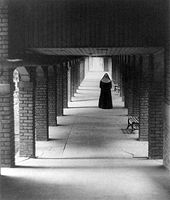nun
A nun is a female member (a religious woman ) of some Christian religious orders as well as of a Buddhist order.
Word origin
The words nonnus and nonna, which were probably created as childish lewd words, denoted people of venerable age in post-classical Latin . Late Latin nonna was an expression for “venerable mother” (cf. Italian nonna “grandmother”, nonno “grandfather”). When Jerome in the 5th century it is attested as an address of the nun. As a loan word that came into German with the monastery system in the 9th century ( Old High German nunna , Middle High German nunne ), the word nun was limited to members of the order .
Christianity
A nun is a female member of a contemplative order in the Roman Catholic , Orthodox, or Anglican Churches. The nun dedicates her life to God and to the service of people through constant prayer, especially the Liturgy of the Hours , which the nuns or choir sisters solemnly perform on behalf of the church in the choir . Nuns are bound to God, the Church and their community by solemn vows and are subordinate to an abbess or prioress .
The terms religious sister and nun are often used synonymously, but despite the fact that they are addressed in the same way as "sister" they do not have the same meaning. According to canon law, nuns are only the sisters of monastic orders who live in papal enclosure . Such orders, whose female members live in papal enclosure, are, for example, the Carthusian Sisters , the Poor Clares (Poor Clares-Capuchin Sisters and Colett Sisters ), the Carmelites , the Camaldolese Sisters , the Redemptorists , the Premonstratensian Choir Women and the orders of the Benedictine religious family, such as the Trappist women . The male equivalent of the nun is the monk .
In his apostolic constitution Sponsa Christi , Pope Pius XII. the characteristics of the consecrated virgin life, the mystical betrothal to Christ and the corresponding foundations of canon law as well as the regulations on which the life of the nuns is based. These regulations were extended by Pope Francis in 2016 and 2018 in the documents Vultum Dei quaerere and Cor orans .
The further distinction between choir sisters (including choir women ) and lay sisters , which previously existed in some contemplative orders , has already been abolished by the decree on the contemporary renewal of religious life, Perfectae caritatis as a result of the reforms of the Second Vatican Council in favor of a “single class of sisters”.
Buddhism
A female member of an order is referred to as a nun in Buddhism. Generally speaking, this means the fully ordained bhikkhuni as it exists in the Mahayana and in parts of the Theravada . Novices ( Samaneri ) or Sikkhamānā who are in the final two-year training period are also referred to as “Buddhist nuns”. Since there is currently no valid nun ordination ( Gelongma ) in the Tibetan lineages ( Vajrayana ) , nuns who are referred to as Gelongma have taken their full ordination in other Mahayana lineages (Taiwan, Vietnam, Korea).
Common, but not applicable, is the term “nun” for Mae Chi and other women clad in white and living in communities who follow six, eight or ten rules. They are more comparable to pious lay people ( Upasika ), but have a significantly lower reputation than lay people who enjoy full civil rights.
A special form are the Siladhara (ten vow nuns), which was introduced in 1983 by Ajahn Sumedho with the permission of the religious superiors in the Thai forest tradition in the western branch of the tradition. From the western point of view, women were able to receive full training to become nuns (Siladhara) without violating the Thai dogma that there can be no nuns (Bhikkhuni); from a Thai perspective, "the worst" was prevented.
See also
Web links
- The Apostolic Constitution Sponsa Christi (Italian)
- German nun life , collected by sisters and nuns from Töss and Engeltal, 1921, full text
Individual evidence
- ↑ Grimm's Dictionary Nun
- ^ Friedrich Kluge , Alfred Götze : Etymological dictionary of the German language . 20th edition. Edited by Walther Mitzka . De Gruyter, Berlin / New York 1967; Reprint (“21st unchanged edition”) ibid 1975, ISBN 3-11-005709-3 , p. 514.
- ^ Instruction on the contemplative life and the retreat of the nuns Venite seorsum of August 15, 1969.
- ^ Instruction on the contemplative life and the enclosure of the nuns Verbi sponsa of May 13, 1999
- ↑ John Paul II, Post-Synodal Apostolic Exhortation Vita Consecrata - On Consecrated Life and Its Mission in Church and World, March 25, 1996
- ^ Decree on the modern renewal of religious life Perfectae caritatis No. 15.
- ↑ http://www.buddhachannel.tv/portail/spip.php?article10061 History of the Siladhara Ordination (Eng.)
- ↑ http://groups.google.com/group/dhammadharini/web/bhikkhuni-and-siladhara-points-of-comparison-faqb questions and answers regarding Buddhist nunnery
